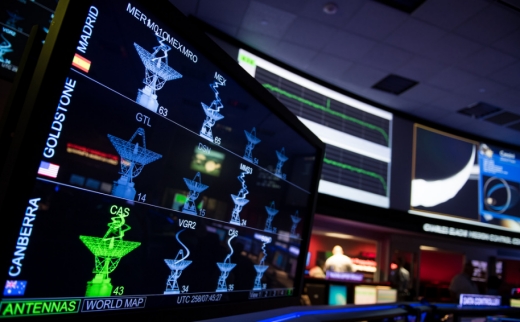
Image: A monitor shows the status of NASA’s Deep Space Network as it receives data from the Cassini spacecraft, Friday, Sept. 15, 2017 in the Charles Elachi Mission Control Center in the Space Flight Operation Center at NASA’s Jet Propulsion Laboratory in Pasadena, California. Credit: NASA/Joel Kowsky.
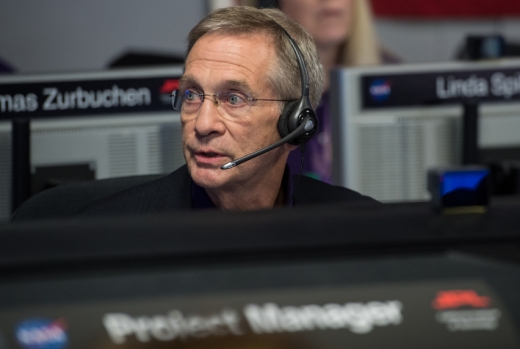
Image: Cassini program manager at JPL, Earl Maize, center row, calls out the end of the Cassini mission. Credit: NASA/Joel Kowsky.
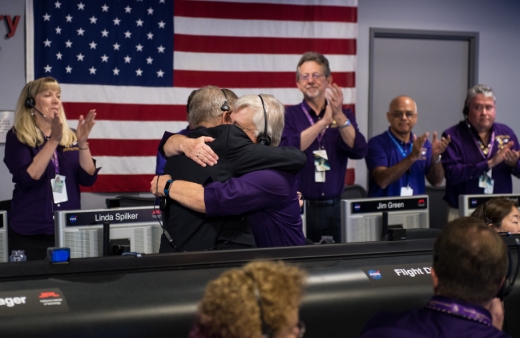
Image: Cassini program manager at JPL, Earl Maize, left, and spacecraft operations team manager for the Cassini mission at Saturn, Julie Webster embrace after the Cassini spacecraft plunged into Saturn, Friday, Sept. 15, 2017 at NASA’s Jet Propulsion Laboratory in Pasadena, California. At left is Cassini project scientist Linda Spilker. At right center is Jim Green, Director of NASA’s Planetary Science Division. Credit: NASA/JPL-Caltech/Space Science Institute.
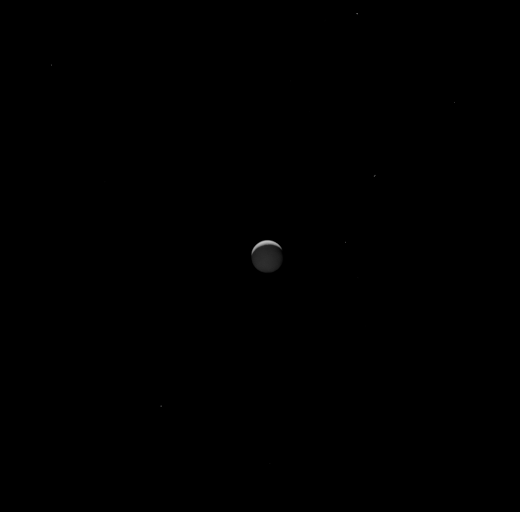
Image: Saturn’s active, ocean-bearing moon Enceladus sinks behind the giant planet in a farewell portrait from NASA’s Cassini spacecraft. This view of Enceladus was taken by NASA’s Cassini spacecraft on Sept. 13, 2017. It is among the last images Cassini sent back. Credit: NASA/JPL-Caltech/Space Science Institute.
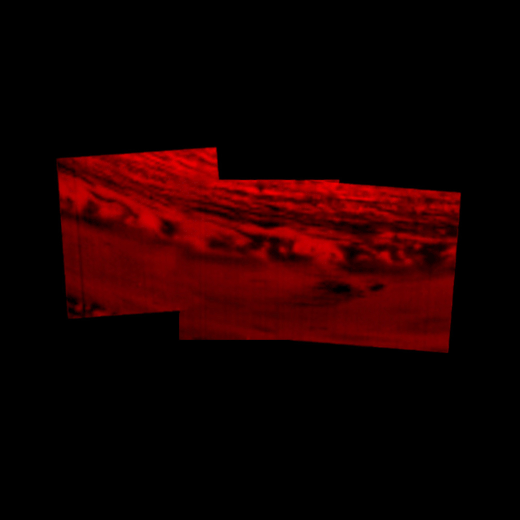
Image: This montage of images, made from data obtained by Cassini’s visual and infrared mapping spectrometer, shows the location on Saturn where the NASA spacecraft entered Saturn’s atmosphere on Sept. 15, 2017. This view shows Saturn in the thermal infrared, at a wavelength of 5 microns. Here, the instrument is sensing heat coming from Saturn’s interior, in red. Clouds in the atmosphere are silhouetted against that inner glow. This location — the site of Cassini’s atmospheric entry — was at this time on the night side of the planet, but would rotate into daylight by the time Cassini made its final dive into Saturn’s upper atmosphere, ending its remarkable 13-year exploration of Saturn. Credit: NASA/JPL-Caltech/Space Science Institute.
“Things never will be quite the same for those of us on the Cassini team now that the spacecraft is no longer flying,” said Linda Spilker, Cassini project scientist at JPL. “But, we take comfort knowing that every time we look up at Saturn in the night sky, part of Cassini will be there, too.”
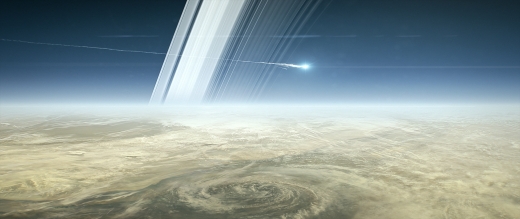


I’m torn between being impressed at how precisely they were able to predict something as seemingly unpredictable as a falling spacecraft losing control due to atmospheric turbulence, timing it to within less than 30 seconds, and being disappointed that Cassini didn’t prove them wrong and keep sending back telemetry far longer than expected.
Goodbye, Cassini! Thanks for 13 great years of adventure in the Saturn system.
Cronus hath eaten another child.
I mourn for the loss of this probe–only the loss of ENVISAT hurt more.
Cassini may be gone but it’s legecy will live on for generations.
Goodby Cassini, poor you could be sent to Uranus, back to Jupiter or even to study centaurs. But they had you stay too long so no fuel left.
Yes it would have slow journey, and a risk of something break down and RTG loosing power.
But no similar mission is planned, so attempting to using the spacecraft somewhere else or for other purpose would have been the best idea.
To late. :/
I posted in the Cassini article before this that they should have attempted to land on Saturn’s moon Methone a while ago. Just as they put NEAR down on Eros even though it was not designed for such a landing.
A landing “in” Methone (rather than on it, as Cassini might have slowly sunk to the “fluffy” moon’s gravitational center) would have been an interesting high-risk, end-of-mission “Hail Mary” exploration. So would–provided that sufficient propellant and/or gravity assists from moons would have made it possible–maneuvering Cassini into the outer rings themselves, to examine them at low relative velocities (its cameras might not have been able to focus on such close-up objects, though; even the Huygens Titan probe had to be miles away before Cassini could take in-focus pictures of it). But:
To my pleasant surprise, Cassini’s end was covered all day on the national radio news, even tonight’s top-of-the-hour midnight news break–that’s unusual, especially for a robotic mission.
Yes snowy Methone could have been last station also.
I do not think the spacecraft would sink.
The surface is like surface of cold winter snow, it melt at RTG end. But the low gravity only compress the snow under the rest.
The last fuel to orient Cassini so instruments have view and the dish point toward the sun at one part of the moon orbit.
Then we could get update and Saturn weather report. =)
We really don’t know how solid Methone is (or isn’t); what I wrote above was what the current speculation is about it. Besides its orbital parameters, all that is known with certainty is that Methone is very smooth, showing no craters or noticeable terrain (these attributes, plus its ellipsoidal shape, give rise to the speculation that Methone may be a loosely-packed, gravitational-tugs-molded “snowball”), but:
A mission to explore both Methone and the nearby rings (from outside them at close range, and from above, below, and inside them) would be an appropriate–and exciting–follow-on to Cassini. A Methone/rings probe could also directly examine–by photography, multi-spectral scanning, and physical contact–ring particles and Methone’s surface and subsurface material.
Now this may be satire, but what if Cassini were equipped with true AI? What if the probe really didn’t want to crash into Saturn just to avoid putting some Earth germs on Titan or Enceladus?
http://www.theonion.com/article/cassini-probe-realizes-too-late-was-setup-all-alon-56949
HAL questioned his ship (and himself) being used as a “first stage” for the Alexei Leonov in “2010.” :-)
I always wanted to know what HAL 9000 would have done had he succeeded in eliminating all the human crew on Discovery 1 and continued with the mission alone as he had been programmed to? What would the Monolith ETI have done if HAL had come through the Stargate rather than David Bowman?
While 2001: A Space Odyssey clearly focused on the descendants of those hairy little creatures roaming the plains of Africa four million years ago as the next step in the evolution of intelligence on Earth, there are those who think the next intelligent species to come from this planet will be made of silicon, not carbon. The film was clearly an organic chauvinist.
Five plans for returning to Saturn:
https://www.nytimes.com/2017/09/15/science/saturn-cassini-return.html
This system is so rich with possibilities it would be a literal crime against humanity not to get back there and soon.
Ljk, there is not enough left fuel on board Cassini to slow it down for a landing like the Near spacecraft due to the orbit Cassini is in.
My plan was something that should have been implemented a while back, when there was enough fuel and they could have used various moons to help slow down Cassini sufficiently.
In any event there should be a dedicated Methone mission. The problem is we won’t see any other Outer Worlds probe missions for at least twenty years.
This article describes a number of scenarios JPL had considered for Cassini, including a mission to Jupiter or Uranus!
http://science.howstuffworks.com/why-cassini-crashed-protecting-icy-moon-enceladus.htm
I get why they sent Cassini on its final course and I largely agree with it, but they still could have planted the probe on a “lifeless” small moon (Methone, cough!) and kept it going as a monitor for the Saturn system until its inevitable demise. There Cassini would have been kept from crashing into and contaminating any of the “cool” moons and been left as a treasure for future space historians, just as NEAR will be for those who one day follow it to the NEO Eros.
In an ideal society with its priorities straight, we would already have a mission dedicated to exploring Saturn’s rings, either something armor-plated or my old idea of a swarm of small probes that look like soccer balls, bouncing off and around the ring particles, taking images and “tasting” them for analysis. Just imagine the images from that perspective.
Could Cassini have made it to Uranus? I mean, yes, it could have gotten there, but would it have had enough fuel to do much science? Seeing as nothing definite is planned for that planet mission-wise, it might have been the right option.
Sunday, September 17, 2017
Machines and People: Why Do We Have Feelings About the End of Cassini?
http://this-space-available.blogspot.com/2017/09/machines-and-people-why-do-we-have.html
To quote:
Robotic explorers’ deaths also seem particularly heroic in that they willfully “plunge” to their deaths, or peter along until they run out of power and/or cease communicating. They aren’t capable of having feelings or reserve about sacrificing their own lives for their journeys, making them uniquely “selfless.”
Then there’s the fact that we tend to give non-living things human characteristics, imposing our hopes and dreams on objects that do not have thoughts or feelings. How many of us have given our cars human names, and collegial “pats” on their hoods or steering wheels? We see untapped promise and potential in things that can bring us closer to our goals, even if they cannot reciprocate in celebrating the achievement.
In keeping with this theme Carl Sagan once wrote, “The unmanned exploration of the solar system initiated by the United States and the Soviet Union is a scientific adventure of historic proportions that will be remembered by our remote descendants after much else of our epoch has long been forgotten – provided that we are not so foolish as to destroy ourselves.”
Ages ago I read a long magazine feature about one of the Pioneer or Voyager probes. The writer quoted one of the people involved in the mission saying something along the lines of, “Please don’t call it a ‘plucky little spacecraft.'” The idea being that it took away from the ingenuity and heroic efforts of the engineers, scientists and countless others who designed, built and operated the machine. That line stuck with me, and when I wrote an article about Venus for a children’s science magazine, I made a point to not anthropomorphize the Russian Venera spacecraft. Though once I did find myself feeling sorry for a Roomba.
The Atlantic tackles the final days of Cassini and our anthropomorphization of a robotic space probe….
https://www.theatlantic.com/science/archive/2017/09/cassini-suicide-mission/539892/
https://www.theatlantic.com/technology/archive/2017/04/cassini-robot-sad/522159/
All these worlds are yours except Enceladus and Titan…
http://science.howstuffworks.com/why-cassini-crashed-protecting-icy-moon-enceladus.htm
To quote:
In 2005, however, the European Huygens probe landed on the moon’s surface. Piggybacking on Cassini since launch as part of the joint NASA/ESA/Italian Space Agency Cassini-Huygens mission, Huygens detached itself, coasted to the moon and descended through its trademark thick yellow haze. But if we’ve already sent a probe there, why worry about contaminating it with Cassini?
“When we landed the Huygens probe on Titan, we had no idea what we’d find on the surface, so it was really the discoveries of Huygens and Cassini that led to these new [planetary protection] requirements,” says Spilker. “Also, Titan is not in the same class as Enceladus for planetary protection.”
To go to Enceladus, she added, any lander would need to be very clean as liquid water is in contact with the moon’s icy surface, so contamination of the subsurface ocean would be a very real possibility. Titan’s ocean, on the other hand, is deep and doesn’t appear to be in contact with the surface, so “this puts [Titan] in a different category,” Spilker says. “While care is still taken with Titan, it’s really Enceladus that we’re most worried about contaminating.”
…
Previous space missions have employed a variety of measures to avoid risking contamination of promising moons and planets, says Soderblom. “The Voyagers we disposed of by ejecting them from the solar system, the Galileo spacecraft was burned up in the atmosphere of Jupiter. The Mars spacecraft were extra, extra carefully decontaminated, and that’s a very expensive process to go through so you can safely leave the spacecraft [on the planet’s surface].”
And with Cassini, there were a variety of options on the table to prevent a collision with Enceladus or Titan, particularly earlier on in the mission.
“Back in 2009 and 2010, we had enough fuel to perhaps leave the Saturn system and go to Jupiter. We could have even gone to Uranus,” remembers Spilker. However, to get to Uranus, it might have taken 20-30 years and mission planners decided that Cassini was really designed for the Saturn system anyway, so they decided to stay.
To avoid the inner Saturn system, they also considered sending Cassini on very wide orbits, staying well clear of the moons. In this scenario, when the spacecraft ran out of fuel, it would forever remain in a holding orbit around Saturn as a new artificial satellite itself.
“We also looked at possibly crashing it into Mimas or one of the other moons,” adds Spilker. “That would have been quite a way to end [the Cassini mission] by making a new crater!”
But when they realized they could send Cassini through Saturn’s rings by using Titan’s gravity to redirect the probe, that option became the clear front-runner. “It didn’t take much discussion because flying through this region would give us brand-new science – it’s like having a new mission,” explains Spilker.
Cassini: The legend and legacy of one of NASA’s most prolific missions
http://www.spaceflightinsider.com/missions/solar-system/cassini-legend-legacy-one-nasa-prolific-missions/
How Cassini Managed to Live Such a Long and Useful Life at Saturn
By Calla Cofield, Space.com Senior Writer | September 21, 2017 01:19 pm ET
https://www.space.com/38190-how-cassini-lasted-so-long-at-saturn.html
Their words: Cassini’s Linda Spilker on mission’s legacy
by Matthew Kuhns
September 23, 2017
http://www.spaceflightinsider.com/space-centers/jet-propulsion-laboratory/cassini-linda-spilker-missions-legacy/
To quote:
Spilker: “Over the next decade or so, new discoveries—you know, we sort of have this firehose of data that we skim the cream the cream off the top of, and when you really dig down, there’s probably more Ph.D. theses in there. There’s going to be a lot more coming out.”
SFI: I can imagine.
Spilker: “It might slow down once the funding slows down, though. That’s the only thing. It will be nice to keep funding an outer planets research program at a reasonable level. But that’s a tough thing.”
SFI: I know Juno’s out there.
Spilker: “Yeah, Juno’s out there and Europa Clipper is the next one up. But we don’t have any flagships going anyplace, and nothing [is] in place. Nothing with the scope of Cassini. Everything else is much more focused.”
SFI: Cassini or Galileo. Something that’s orbiting there for years.
Spilker: “That’s right. I think we need like a Cassini 1 and a Cassini 2. Launch them together and fly them out to Jupiter – send it out to Uranus and the other out to Neptune. And just like you flew [the] Voyager[s], and even though they are orbiters, they would arrive at very different times, so you could probably do the operations.
SFI: Lots to learn about Neptune and Uranus.
Spilker: “Absolutely! Just one flyby is just so different. Yeah, yeah… absolutely.”
Saturn has everything, including kittens:
https://whyevolutionistrue.wordpress.com/2017/09/29/cassini-reveals-saturns-kittens/
News | October 11, 2017
Reconstructing Cassini’s Plunge into Saturn
As NASA’s Cassini spacecraft made its fateful dive into the upper atmosphere of Saturn on Sept. 15, the spacecraft was live-streaming data from eight of its science instruments, along with readings from a variety of engineering systems. While analysis of science data from the final plunge will take some time, Cassini engineers already have a pretty clear understanding of how the spacecraft itself behaved as it went in. The data are useful for evaluating models of Saturn’s atmosphere the team used to predict the spacecraft’s behavior at mission’s end, and they help provide a baseline for planning future missions to Saturn.
Chief among these engineering data, or telemetry, are measurements indicating the performance of the spacecraft’s small attitude-control thrusters. Each thruster was capable of producing a force of half a newton, which is roughly equivalent to the weight of a tennis ball on Earth.
Full article here:
https://www.jpl.nasa.gov/news/news.php?feature=6972&utm_source=iContact&utm_medium=email&utm_campaign=NASAJPL&utm_content=daily20171011-2
To quote:
“Given that Cassini wasn’t designed to fly into a planetary atmosphere, it’s remarkable that the spacecraft held on as long as it did, allowing its science instruments to send back data to the last second,” said Earl Maize, Cassini project manager at JPL. “It was a solidly built craft, and it did everything we asked of it.”
Cassini was sent on its way to Saturn twenty years ago on October 15, 1997:
http://www.americaspace.com/2017/10/15/billion-mile-trek-to-saturn-20-years-since-the-launch-of-cassini/
NASA JPL News | October 16, 2017
Fresh Findings From Cassini
NASA’s Cassini spacecraft ended its journey on Sept. 15 with an intentional plunge into the atmosphere of Saturn, but analysis continues on the mountain of data the spacecraft sent during its long life. Some of the Cassini team’s freshest insights were presented during a news conference today at the American Astronomical Society Division for Planetary Science meeting in Provo, Utah.
https://www.jpl.nasa.gov/news/news.php?feature=6976
To quote:
“There are whole careers to be forged in the analysis of data from Cassini,” said Linda Spilker, the mission’s project scientist at NASA’s Jet Propulsion Laboratory, Pasadena, California. “In a sense, the work has only just begun.”
Reliving Cassini’s Final Moments: Engineers Recreate Spacecraft’s Fatal Plunge Into Saturn’s Atmosphere
By Paul Scott Anderson
It has been just over a month now since the Cassini spacecraft took its final plunge into Saturn’s atmosphere, ending an incredible mission of 13 years at the ringed giant planet. The probe continued collecting scientific data until the very last moments, and now engineers have been able to reconstruct what happened to it as it met its fate.
The descent into the thick atmosphere was a fiery one with Cassini being increasingly buffeted and battered by atmospheric winds. At first however, the spacecraft was gently rocking back and forth by only fractions of a degree as it made its final approach to Saturn, with only Saturn’s gravity trying to tug at and rotate Cassini.
http://www.americaspace.com/2017/10/16/reliving-cassinis-final-moments-engineers-recreate-spacecrafts-fatal-plunge-into-saturns-atmosphere/
Why should we go? Reevaluating the rationales for human spaceflight in the 21st century
October 16, 2017
A perennial struggle for space advocates has been developing rationales for human spaceflight that can be sustained over the long term.
Cody Knipfer argues that now is the time to reexamine those arguments, particularly given the rise of commercial human spaceflight.
http://www.thespacereview.com/article/3351/1
Saturn’s ring system stays together by the corralling action of its many moons:
http://mediarelations.cornell.edu/2017/10/17/to-keep-saturns-a-ring-contained-its-moons-stand-united/
An amazing image of Saturn’s moon Daphnis making literal waves in the planet’s rings:
http://spaceref.com/saturn/daphnis-makes-waves-in-saturns-rings.html